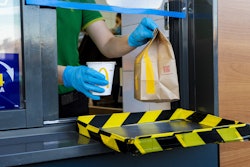
Despite the disruption and uncertainty that the Coronavirus disease (COVID-19) pandemic has created for the manufacturing world, growth and activity levels are strong, with considerable gains over the last few months. However, while growth still continues, it has slowed, and slower growth does serve as a reminder that the industry is not clear, by any means, of complications created by the pandemic, despite the economy slowly beginning to open up.
In the food manufacturing segment, there are two challenges it faces in the coming months—one is to be more productive and expand production capacity, and the other is to keep workers safe.
In terms of demand in the food segment, the real challenge comes with navigating consumer behaviors and adjusting accordingly. Above all, it requires manufacturers to find ways to be more efficient to either offset weaker margins because of reduced demand or to ramp up production to meet higher demand. On the safety front, reducing risk around the potential viral spread on the shop floor is not only vital for worker health and well-being, but also critical for business continuity – after all, it is human workers who are integral to keeping manufacturing plants running, not robots.
Safety and efficiency are by far the two most important factors in helping food manufacturers weather the storm that COVID-19 has created and its resulting economic impacts. While safety policies and smart business strategies certainly will help to support safety and efficiency, advancements in technology, specifically technology that is made to support and augment the human worker, will be a pivotal part of the journey.
Meeting increases in demand effectively and offsetting costs with efficiency
Lack of demand for certain food categories is not an issue – the issue, in many cases, is surging demand. One consumer trend that food manufacturers must tackle is the reality that people simply require more groceries in their households now, as a result of fewer dining out options, as well as remote work realities that have people eating most of their meals at home. Then there is the reverse of that – with the decline of on-premise consumption that occurs with increased social distancing, some food and beverage products are seeing a negative impact to their margins. Ultimately, food manufacturers are in one boat or the other, and both need to ramp up production efficiency to better accommodate shifts in demand.
For complex food manufacturing plants, ramping up production cannot simply happen with the flick of a switch – it requires a dedicated, plant-wide effort and adjustments to all the processes that create or play a role in creating the final end-product.
Connected worker technology helps manufacturing workers execute work more effectively and enables workers to make quick adjustments to increase production output. First, it digitizes paper-based standard operating procedures (SOPs), so that workers are more mobile and connected with their colleagues. Through the SOPs, the technology guides human inputs and actions to ensure sure every job is done right, every time. This is a key step to ensuring more efficiency and faster-paced production – it also helps to guide workers on new processes or ways of approaching processes, with instructions built directly into the platform, to account for greater output.
In the food manufacturing process, there is also an incredible amount of food and resource waste that occurs, limiting the amount of overall end-product that can be distributed and sold. Much of that waste comes from human error in the manufacturing process, where workers either were not trained correctly, did not know how to approach the work or did not realize the work was done wrong. In fact, a recent study found that human error accounts for nearly 11% of food waste in manufacturing. In some ways, connected worker technology is like having a work mentor by your side as you work.
It all comes down to consistency and execution and making sure everybody is doing what they are supposed to be doing. A spoiled food batch is a waste of raw materials, resources, energy, time and money. If the spoiled food batch leaves the manufacturing plant and goes to the warehouse, it requires significant spend to get it back. Even worse? If it makes it to store shelves, it requires a public recall which is not good for any brand. The reduction in food waste is valuable for any food manufacturers, whether their aim is to ramp up production or save on inefficiencies to offset lack of demand.
Data leading to more visibility
The other interesting component of connected worker technology is that it captures and collects operational data, ultimately giving more insight to management into the effectiveness of production and overall performance. Without technology, the manual capture of data is challenging and can often lead to pencil-whipping. Connected worker technology helps you to consume granular data quickly, without all the input, resources and handoffs to different people that might occur if done manually. The technology ultimately helps manufacturers to solve for smaller problems, and the beauty of solving for smaller problems is that smaller problems often lead to the bigger problems that directly impact production.
Leveraging technology insight to see, for example, that a nozzle on a filling machine is not working properly, helps manufacturers to tackle a smaller issue within the filling machine before it creates additional problems within the larger filling process. Production downtime that results from a malfunctioning process ultimately puts a dent in output capability, so minimizing its risk is critical in today’s uncertain and volatile environment.
Increasing production capacity
Finally, every food manufacturer has a certain nominal capacity within their processes and production lines, but by using Connected worker technology insights to curb performance losses that occur in those lines, it can lead to higher production capacity. For example, if a food manufacturer has a production line of jars, but its capacity is at 80%, a surge in demand that requires more output is possible by eliminating some production losses. Increasing capacity by even 5% could mean that demand is met in a matter of weeks or a couple months instead of several months. Connected worker technology helps organizations find new efficiencies within production, highlighting areas that could use improvement, without needing to open another line of production to meet demand, saving on resources and expenses.
Keeping workers healthy
Connected worker technology not only enables manufacturing plants to account for more production efficiency, but also has the added benefit of being able to account for increased worker safety or adherence to safety procedures. SOPs built into the technology can alert and remind workers to wear face masks or maintain social distancing. Additionally, as the technology also captures all operational data in a plant, if a plant worker does contract the virus, understanding who at the plant encountered that person or worked on the production line with that person is easier to determine.
Technology will play a vital role in helping food manufacturers with business resiliency in the year to come. Uncertain times require more operational agility in the manufacturing world, and technology can provide it.




















